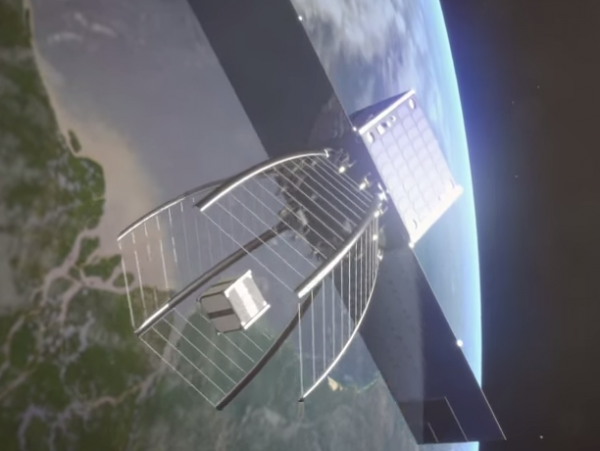‘Pac-Man’ Spacecraft: Meet The Garbage Collector In Space
| KJ Belonio | | Jul 07, 2015 07:07 PM EDT |
(Photo : YouTube/École polytechnique fédérale de Lausanne (EPFL)) The “Pac-Man” solution will use a spacecraft with a big conical net extending from the front that closes as soon as it gobbles up the satellite.
Can you imagine a garbage collector in space? Well, a new research project is about to launch a spacecraft into Earth's low orbit to collect and dispose litters in space. The project is part of a cleanup drive on the increasing amount of space junk.
The Ecole Polytechnique Federale de Lausanne (EPFL) Center for Space Engineering's CleanSpace Project has been working on the growing concern on how to safely track, collect and dispose satellites that have outlasted their usefulness but aren't going to return to Earth at all. So in order to cleanup orbiting clutter, the team decided Monday to use the "Pac-Man" technique, NBC News has learned.
Like Us on Facebook
The "Pac-Man" solution will use a spacecraft with a big conical net extending from the front that closes as soon as it gobbles up the satellite. Their target is a cubesat named SwissCube, only 4 inches to a side.
"The idea is to have the biggest aperture possible, to increase the chance to eat the cube while it's near the chaser," EPFL's Michel Lauria explained in a video showing the prototype.
Since Swiss space experts wanted to eliminate the threats of the existing space garbage, which put satellites and astronauts at risk for junks with speeds of up to 15,000 mph, they settled to launch the "CleanSpace One" mission. According to Engadget, the operation will be tricky since just looking for the 4-inch by 4-inch satellites is going to be a tough job.
Moreover, researchers are also establishing a high dynamic-range camera and image processing system that can spot bright reflections coming off the SwissCubes as they orbit in space, Wired noted.
Meanwhile, extra care should be taken in this project because if the net doesn't deploy, the cubes could bounce off the cleanup satellite and end up in a worse spot than before. So, exact measurements of position and speed are quite essential in this mission.
And to avoid this disaster, scientists are currently testing the visual approach algorithms on the clean-up satellite's cameras. Daily Mail reported that to be accurate, experts have to consider a variety of parameters, such as the angle of illumination of the sun, the physical data of CubeSat, the relative speed at which it is moving. They should also take into account all the uncertainties involved in the measurement and the speed of its own rotation.
As of now, the system has passed the prototype stage. Researchers are still working on further development and testing. With luck, Popular Mechanics revealed the "CleanSpace One" mission could launch in 2018.
TagsPac-Man, spacecraft, outer space, CleanSpace One, Pac-Man Spacecraft
©2015 Chinatopix All rights reserved. Do not reproduce without permission
EDITOR'S PICKS
-

Did the Trump administration just announce plans for a trade war with ‘hostile’ China and Russia?
-

US Senate passes Taiwan travel bill slammed by China
-

As Yan Sihong’s family grieves, here are other Chinese students who went missing abroad. Some have never been found
-

Beijing blasts Western critics who ‘smear China’ with the term sharp power
-

China Envoy Seeks to Defuse Tensions With U.S. as a Trade War Brews
-

Singapore's Deputy PM Provides Bitcoin Vote of Confidence Amid China's Blanket Bans
-

China warns investors over risks in overseas virtual currency trading
-

Chinese government most trustworthy: survey
-

Kashima Antlers On Course For Back-To-Back Titles
MOST POPULAR
LATEST NEWS
Zhou Yongkang: China's Former Security Chief Sentenced to Life in Prison

China's former Chief of the Ministry of Public Security, Zhou Yongkang, has been given a life sentence after he was found guilty of abusing his office, bribery and deliberately ... Full Article
TRENDING STORY

China Pork Prices Expected to Stabilize As The Supplies Recover

Elephone P9000 Smartphone is now on Sale on Amazon India

There's a Big Chance Cliffhangers Won't Still Be Resolved When Grey's Anatomy Season 13 Returns

Supreme Court Ruled on Samsung vs Apple Dispute for Patent Infringement

Microsoft Surface Pro 5 Rumors and Release Date: What is the Latest?










